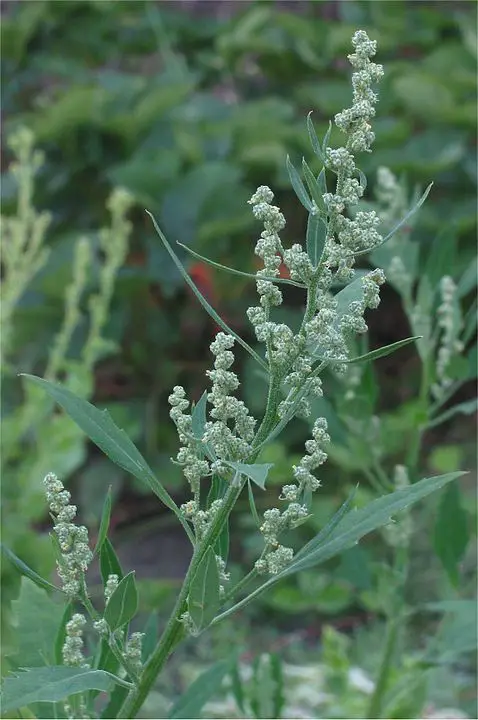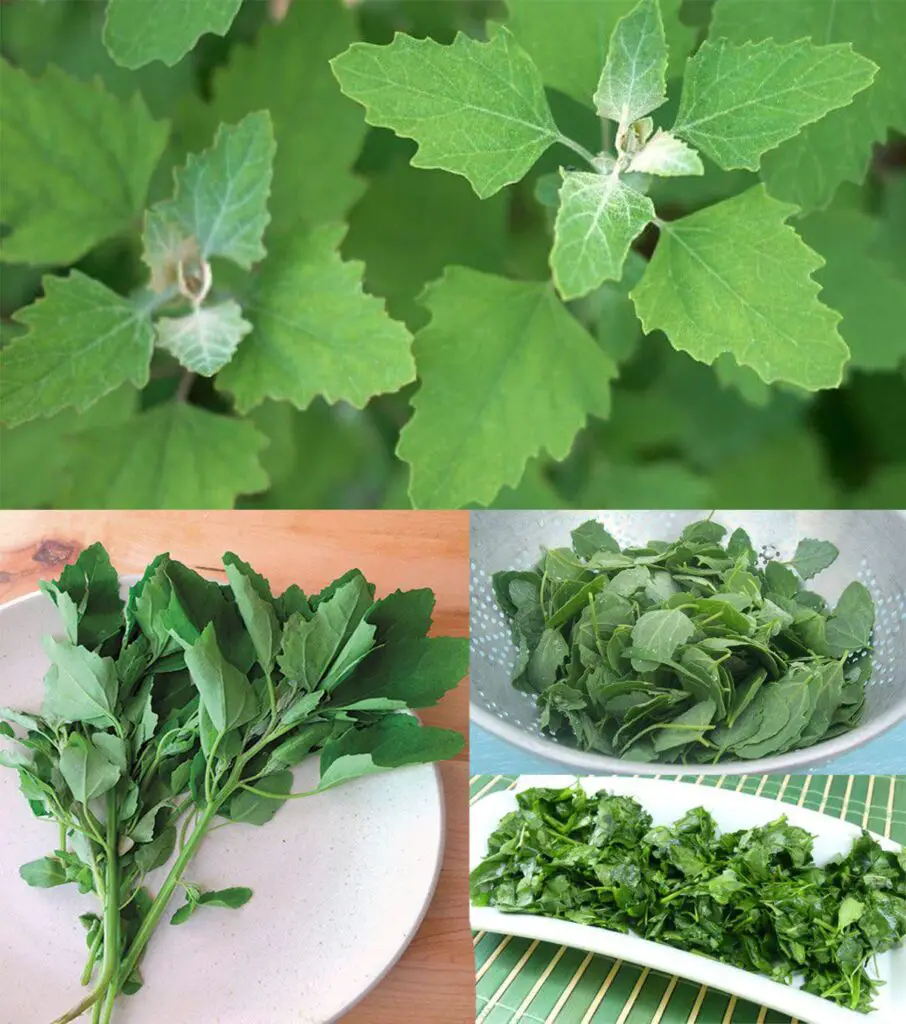Lamb’s Quarters And the Superfood Benefits of Wild Spinach
Ever stumbled upon a green so packed with nutrients it could give spinach a run for its money?
Meet Lamb’s Quarters, or Chenopodium albium, the underdog of the weed world that’s not only a culinary chameleon but also a powerhouse of health benefits.
With a quirky name that sounds more like a cozy inn than a leafy green, Lamb’s Quarters, or wild spinach, is the unsung hero in my kitchen and possibly your next favorite green.
This wild edible doesn’t just play well with others in a stir-fry or salad; it’s a nutritional heavyweight.
Imagine loading up on more than 70% of your daily Vitamin A and nearly all your Vitamin C in just one cup.
Plus, it’s brimming with B Vitamins and protein. But wait, there’s more!
Beyond its impressive resume for internal health, Lamb’s Quarters has been a go-to for natural remedies, tackling everything from gastrointestinal issues to skin irritation.
This leafy green deserves a spot on your plate and in your medicine cabinet.
Nutritional Benefits of Lambs Quarters (Wild Spinach)

Essential Vitamins and Minerals
Digging right into the heart of Lambs Quarters’ nutritional portfolio, I find it astounding how packed this wild green is with essential vitamins and minerals.
We’re talking a powerhouse of vitamin A, critical for maintaining healthy vision, skin, and immune function.
A single cup, or roughly 35 ounces, of raw Lambs Quarters can deliver up to 73% of your recommended daily intake of vitamin A.
But that’s not all – this wild spinach takes it up a notch with its vitamin C content, offering a whopping 96% of your daily needs in just one serving.
Given its role in bolstering the immune system and acting as an antioxidant, it’s a no-brainer why including Lambs Quarters in your diet is a smart move.
It doesn’t stop there. Lambs Quarters shine in the B vitamins department, too, boasting considerable amounts of thiamine, riboflavin, and niacin.
These B vitamins are your body’s fuel converters, turning what you eat into the energy you need to thrive.
And let’s not forget about the minerals. Calcium for bones, iron for blood, and magnesium for virtually everything else – from muscle function to nerve transmission.
Lambs Quarters have these in abundance, making them an essential addition to a balanced diet.
Advantages Over Traditional Spinach
You might be wondering, “Why should I bother with Lambs Quarters when I’ve got good old spinach at home?”
Well, let me tell you, Lambs Quarters offer a few intriguing advantages over their cultivated cousin.
For starters, their nutrient density is simply higher.
We’ve already covered how Lambs Quarters are loaded with vitamins A and C, but it’s worth mentioning again that these levels surpass what you’d typically get from an equal amount of traditional spinach.
This means you’re getting more bang for your buck in terms of nutrition.
Beyond just vitamins and minerals, Lambs Quarters are a robust source of dietary fiber, which is essential for maintaining a healthy digestive system.
They also have a lower oxalate content compared to regular spinach.
High levels of oxalates can interfere with the absorption of essential nutrients like calcium and iron, so by opting for Lambs Quarters, you’re making it easier for your body to utilize these vital minerals.
Plus, Lambs Quarters adapt to a variety of soil conditions and stages of growth, which makes them not only versatile in the kitchen but also ensures a more consistent and sustainable harvest.
Whether you’re tossing them fresh into a salad, juicing them, or adding them to any recipe that calls for greens, their unique flavor enriches dishes in a way traditional spinach just can’t match.
Foraging for Lambs Quarters

How to Identify Lambs Quarters in the Wild
Identifying lambs quarters, or Chenopodium albium, in the wild becomes a breeze once you know what you’re looking for.
This wild green carries a distinctive look. Its leaves, somewhat similar in shape to a goose’s foot, are one of its defining features.
In the early stages, you’ll notice a powdery substance on the leaves and stems, making it easy to distinguish from other greens.
When it blooms, the plant displays tiny green flowers that eventually turn into edible seeds.
One tip I always share is to look for lambs quarters in areas that are slightly disturbed or where the soil isn’t heavily cultivated.
You might be surprised to find it in your backyard, community gardens, or along field edges.
Remember, though, never to forage near roadsides or in areas that might have been subjected to chemical sprays.
Best Practices for Harvesting
Harvesting lambs quarters is as straightforward as its identification.
The trick is to focus on the young and tender plants for the highest nutritional value and optimal taste.
Here’s how I do it: I gently cut or snap off the top few inches of the plant.
This part is usually the most tender and flavorful. If the stems start to feel tough, I stick to harvesting just the leaves and the tender tips.
Timing is key when foraging for lambs quarters. Early morning, just after the dew has evaporated, is ideal.
This is when the plants are most hydrated, ensuring you get the most out of your forage.
Technique matters, too. Use a sharp knife or scissors to avoid damaging the plant, and always leave enough behind so it can continue to grow.
This sustainable practice ensures that you can come back to the same spot and forage again later in the season.
Culinary Uses of Lambs Quarters
Cooking Ideas and Tips
Lamb’s Quarters packs a punch in the kitchen with its versatility and rich flavor.
I’ve found that its tender leaves blend seamlessly into any dish that calls for spinach, elevating the taste and nutrition profile.
For starters, incorporating Lamb’s Quarters into salads adds a delightful, slightly nutty flavor that makes every bite more interesting.
I also love using it in smoothies for a nutrient boost that doesn’t overpower other ingredients.
Sautéing Lamb’s Quarters with a bit of garlic and olive oil unlocks its earthy taste, creating a perfect side that complements any main dish.
Moreover, it’s a game-changer in soups and stews, where it wilts down to a comforting, silky texture.
For a breakfast twist, mixing these greens into scrambled eggs or omelets introduces a pop of color and heaps of vitamins without much effort.
One of my top tips? Always give Lamb’s Quarters a good rinse to remove any dirt or grit.
And, don’t shy away from using the stems in your cooking—just chop them finely, and they’ll soften up nicely when cooked.
Recipes to Get Started
Embarking on your culinary adventure with Lamb’s Quarters is straightforward.
One of my go-to recipes is Wild Spinach Pies, a twist on the traditional Spanakopita, using filo pastry to encase the delicious greens mixed with feta cheese. It’s a crowd-pleaser whether you’re making a large pie or individual portions.
Then there’s the Lamb’s Quarters pesto. Simply blend these greens with garlic, pine nuts, parmesan, and olive oil for a unique twist on the classic pesto.
This version serves as a fantastic base for a wild green pizza, replacing tomato sauce for a summer delight.
For something simple yet utterly satisfying, sautéed Lamb’s Quarters make a stunning accompaniment to any meal. J
ust a quick stir-fry with garlic, a pinch of salt, and your choice of spices, and you’ve got a side dish that’s both nutritious and delicious.
Storing and Preserving Methods
To make the most out of Lamb’s Quarters, proper storage and preservation are key.
In my experience, these greens keep well in the refrigerator for a few days when wrapped in a damp cloth and stored in a reusable bag.
This method keeps them fresh and crisp, ready for your next culinary creation.
For longer preservation, blanching and freezing Lamb’s Quarters work wonders.
Blanch the leaves for one to two minutes, plunge them into ice water to stop the cooking process, then drain and pack them into freezer bags.
This technique locks in the flavor and nutrients, ensuring you have a stash of wild spinach at your disposal any time of the year.
Drying is another excellent way to preserve Lamb’s Quarters.
Spread the leaves on a baking sheet and dry them in an oven set to the lowest temperature until they’re completely dehydrated.
Once dry, crumble the leaves and store them in an airtight container.
They can be rehydrated in soups and stews or used as a seasoning, adding a touch of wilderness to your dishes.
Medicinal Uses and Health Claims
Traditional Medicinal Practices
Lamb’s Quarters has been a staple in traditional medicine for centuries, used for its wide array of health benefits.
Its integration into medicinal practices isn’t just based on folklore; research backs many of these uses, making it a fascinating plant with much more than meets the eye.
In traditional medicine, lamb’s quarters is lauded for its ability to soothe various external complaints.
This includes treatment for insect stings, bites, and eczema.
The method? Soaking in bathwater infused with lamb’s quarters tea, which tones and tightens the skin.
This isn’t just a practice rooted in old wives’ tales—there’s genuine relief to be found in the natural properties of this plant.
For more targeted applications, such as burns, applying a poultice made from the leaves offers soothing properties.
This practice isn’t arbitrary; the leaves possess qualities that indeed alleviate pain and promote healing in minor skin injuries.
Interestingly, modern studies have confirmed that lamb’s quarters can positively affect chronic wounds, showcasing its potential beyond traditional uses.
Beyond skin health, lamb’s quarters has been used as a mild laxative, addressing digestive issues without harsh effects.
This gentle approach to enhancing digestive health speaks to the plant’s versatility and its place in traditional health practices.
It’s not just hitting one note; it’s playing an entire symphony of benefits.
The plant’s antioxidant capacity shouldn’t be overlooked, either.
With greens and seeds rich in compounds that eliminate free radicals, lamb’s quarters offers a natural way to combat oxidative stress.
This property extends its usefulness beyond topical treatments, cementing its role in traditional medicinal practices as a plant with both internal and external benefits.